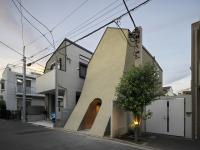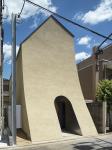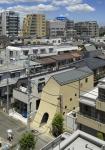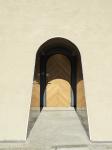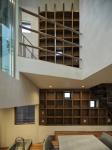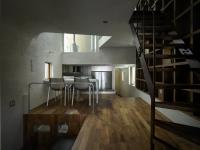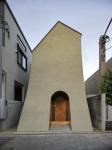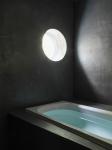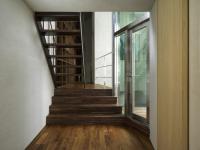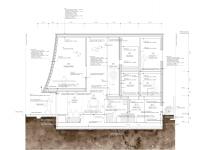A building that floats a few centimeters above our daily lives
On a small narrow plot (4.9 m wide, 14.7 m deep) in metropolitan Tokyo sits a wooden house. The clients are an up-and-coming manga artist, her partner, and two owls who are the new additions to the family. The manga artist made three requests: First, the house should accommodate the entire process of the artist’s work, from creative concept to completion, meetings, and giving media interviews. Second, the house should be compact and should not open to the outdoors too much. Lastly and most importantly, the house should spark inspiration for creativity. Envisioned as “a building that floats a few centimeters above our daily lives,” we strived to ensure that the dwelling is still tied to our tangible daily life but evokes a sense of fictional narrative.
The project began by selecting a plot closely linked to manga artists. The west facade facing the front road is designed as a warped seismic wooden wall evoking earth rising dynamically from the ground, with a tunnel penetrating the wall leading to the entrance. The opening in the solid wall invites visitors to step out from their ordinary and into the extraordinary, evoking a scene in a film. The overall plan is designed to maximize the narrow and long plot of land, comprising the east area with three floor levels at the rear of the site and the west area with two floor levels to create a split-level floor plan. We rearranged the sequence of alternating split levels and created substantial differences in elevation. A light court (1.2 m wide, 5.5 m maximum height) is provided on the north side of the house, and the number of other openings were limited as much as possible to create a contrast between light and dark in a “void” spreading throughout the house like an amoeba. A stairway runs up through the void space filled with contrasts of high/low and light/dark, making a three-dimensional composition that evokes a narrative experienced through the body.
The lifestyles of manga artists have changed dramatically during the COVID-19 pandemic. We no longer see assistants gathering at an artist’s atelier since online production has become the mainstream of manga creation. Alternatively, their private houses have become a place for meetings and serve as studios for interviews and accommodating the press. The work of a contemporary manga artist could be divided into three stages: 1. Creation (enclosed and secluded), 2. Meetings (partially opened to others), and 3. Giving interviews (opening to the public), and the shades of public/private required in each stage varies. We designed a void with contrasts of high/low and light/dark to provide unenclosed yet defined areas, or what the architect calls “ponds and banks,” that would allow for subtle and flexible use of space in a very compact dwelling. We strive to continue creating architecture that embraces open narratives connected with the locality while pursuing logical solutions.
text by Tan Yamanouchi, principal architect
2021
2022
A Japanese Manga Artist’ s House
Location / Tokyo, Japan
Building type / Housing
Architectural design
Architect:
Tan Yamanouchi & AWGL
/ Tan Yamanouchi (Pricipal architect)
Structural engineer:
Graph Studio
/ Yuko Mihara
Construction
Constructor:
Taishin Kensetsu
/ Yasuhiro Ikebe, Keisuke Nishide
Structure
Wooden framework method (Japanese traditional construction module)
Concrete mat foundation
Scale
2 floors above ground and 1 basement floor
Maximum height 8,020mm
Site area 74.0 ㎡
Building area 44.16 ㎡
Total floor area 86.45 ㎡
B1F 19.31 ㎡ 1F 35.04 ㎡ 2F 32.10 ㎡
Period
Design May 2020 ~ Sep 2021
Construction Oct 2021 ~ Sep 2022
Architect:
Tan Yamanouchi & AWGL
/ Tan Yamanouchi
Structural engineer:
Graph Studio
/ Yuko Mihara
Constructor:
Taishin Kensetsu
/ Yasuhiro Ikebe, Keisuke Nishide
A Japanese Manga Artist’s House by Tan Yamanouchi in Japan won the WA Award Cycle 43. Please find below the WA Award poster for this project.
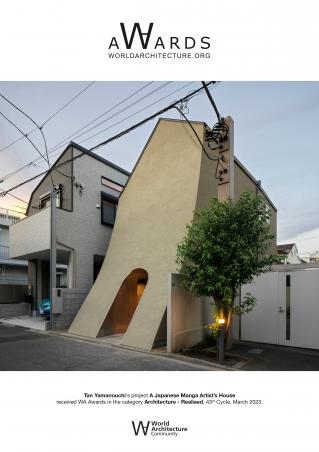
Downloaded 0 times.


